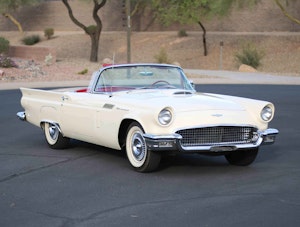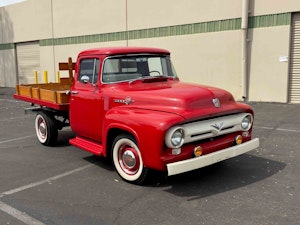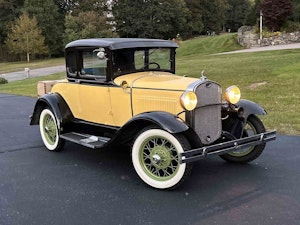Media | Articles
Chasing 200 MPH at Bonneville in a British-American Hybrid
We’ve been visiting the Bonneville Salt Flats for Speed Week each year for more than a decade, yet each time we go, we’re in awe of the incredible variety of cars we come across. From hot rod spectator cars to finely crafted roadsters, ’70s production cars to streamliners of all shapes and sizes, there’s a class for virtually every creation you can imagine. Still, after all that time, we were surprised to come across a Jensen C-V8 running a blown Mopar big-block.
We spoke with the car’s owner and driver, Ian Northeast, and he was kind enough to let us take some photos and also explain how this British car and driver wound up racing on the salt.

Around 20 years ago, when Northeast was in the market for a classic car, he had a few criteria that helped him narrow his search. He wanted a vehicle that was older than he was—Northeast himself is a fine vintage but we’d not classify him as classic just yet—that was also something out of the ordinary. It also had to be relatively affordable. A Jensen C-V8 fit the bill perfectly. As Northeast put it, “The car is very unusual in design as it has a British-designed body and interior coupled with an American drivetrain. The Chrysler 383 and TorqueFlite were fitted as standard, making for a very powerful and elegant GT car that was more than a match for its more popular peers.”
Northeast thought that the car’s low production numbers, unique styling, and what is essentially a muscle car powerplant made a great combo. “I purchased my car from the son of the original owner. It was in very poor condition but was fully road-legal and had just over a quarter of a million miles on it. This made it affordable, but more importantly, I could carry out a rolling restoration. Over the next few months, I fully restored the chassis and mechanicals, without having to take the car off the road for more than a weekend. So, before I knew it, I had a reliable, powerful, and really cool daily runner,” said Northeast.
What began as a fun project car for the street soon turned into an autocross and time attack machine. “The car is one of only 500 made, so pretty much everything I needed, except for the engine work, was going to have to be bespoke or require fettling to make right,” said Northeast. “Before long, the lap times were dropping and the top speeds were getting higher. Although I still wasn’t winning any races, I was having an absolute ball.”
Marketplace
Buy and sell classics with confidence
With the car’s added power and improved suspension leading to higher speeds, Northeast began to wonder how fast the car could go if it had enough room to go all out. He picked a goal of 200 mph and, inspired by the unexpected death of a friend, decided that he’d regret not taking the opportunity to test the car’s potential. “This was to be a one-off attempt and we were going to make the most of it as far as we possibly could,” said Northeast.

That was in 2018, and Northeast and his friends worked hard to get the car the power and gearing it would need to make a solid run. The 383 was bored and stroked to 496 cubic inches, and they added a five-speed manual transmission. The safety was also beefed up with a roll cage and fire system. The team shipped the car from Northeast’s home in England to Galveston, Texas, and towed it the remaining 1500 miles to Bonneville. The crew got a warm welcome from fellow racers, but the team learned the salt was unforgiving. “We were so poorly prepared, we managed to break every part of the car, from the starter motor, battery, clutch, and eventually the gearbox,” lamented Northeast. “We made quite a few runs and represented ourselves well. Upon return to the U.K., we all decided that we had gone fast enough to prove we could go a lot faster, and we really ought to have another attempt in 2020.”



Once the car was back at home in the garage, it underwent a major mechanical makeover. The engine remained, but it was given a monster turbocharger and backed with a more robust transmission, a Tremec T-56. “Due to the corrosion of fifty years of English winters and a week on the salt, we had to rebuild some chassis supports and took the opportunity to change the rear leaf springs for a four-link with bespoke coilovers,” said Northeast. The front suspension also got a modern upgrade to be adjustable like the rear. Northeast told us that the biggest performance increase came from the revamped aerodynamics. A new, larger rear wing replaced the one they’d used on the salt in 2018. A new belly pan, sitting below the car and just 1.5 inches above the ground, cleans up the air under the car. To reduce drag going over the car, the grille was sealed up. “We fully enclosed the bonnet,” said Northeast. Without any air flowing through the radiator, the big Mopar now relies on a 45-gallon water tank to keep it cool during its five-mile runs at wide-open throttle. Thanks to its big turbo and adjustable wastegate, power can be dialed in from 800 to about 1200 horsepower.
Despite all the efforts to transform the car into a proper salt racer, 2020 had other plans. Speed Week that year was a meager affair thanks to Covid. Travel restrictions meant that Northeast and his team wouldn’t make it. The team tried to make it in 2022, but rainstorms put an end to all racing. “The weather in 2023, whilst way better than 2022, was dreadful,” recalled Northeast. “The surface was very wet, soft, and pitted. It was so bad we only managed three runs, although we still managed to increase our top speed by 15 mph. As the weather was so bad, our teammate Bruce from F&B Performance offered to store the car in California. After a two-day trip down to El Mirage the following November, we all headed back out to Bonneville for the 2024 event.”
Thankfully, 2024 proved to be more agreeable. “It was hot, dry, and although the salt was thin, it was smooth and flat, perfect for us to really stretch our legs,” said Northeast. The team’s first shakedown run saw a new personal best speed. “We were going so much faster without trying. After some more excitement when we managed to destroy the rear differential and some electrical issues which stopped us really pushing on, we didn’t get on top of the gremlins until the last day of the event.”

Hoping to finally pass the 175-mph mark, Northeast strapped into the Jensen for his second run on Speed Week’s final day of racing. “The adrenalin was kicking in as I stared down to the floating mountain, running through the gear changes in my mind,” said Northeast. “Once the starter gave me the signal to go, I was off the line as quickly as possible. I managed to control the wheelspin by the time I got to third gear and was really starting to enjoy myself. As I went up the gearbox, just after I changed up to fifth gear, I went through the two-and-a-quarter mile marker at over 175 mph and carried on accelerating through a worn-out fourth mile and averaged 184 mph. This turned out to be our fastest run to date, and the electrical demons made a reappearance for our last run.”
Northeast and his team have worked hard to get so far, but they’re not done chasing 200 mph. “We were so close to our target of 200 mph that we have made the decision to give 2025 our very last effort,” said Northeast. “Regardless of what happens, the car will be returning to the U.K., where its next adventure awaits. We have a few ideas to perfect the aerodynamics and try and make the car a bit more stable at these speeds, but we have done all of this on such a tight budget that to even be this close to our aim is a miracle in itself.”

It took quite an effort to get the rare British/American hybrid from a worn-out relic to a salt-spraying racer. Northeast was quick to point out the many teammates that were instrumental in the build. “I was enabled, encouraged, and am forever in debt to the following people and their families: Andy Best, Harry Smith, Bruce Bridges, Rich Stratford, Dale Berry, Pete Riley, plus the countless supporters and subscribers to our newsletters.”
Northeast hopes that he and his friends, and their collective adventure, will show that there are a lot of ways to enjoy a vehicle. “Cars and motorcycles are not designed to sit around and be polished or stored away to accumulate money, they are designed to be driven,” Northeast added. “Whilst we certainly don’t recommend anything as extreme as a trip to Bonneville, why not do a bit of touring? Drive to another state or country, just spend some time in your car traveling to a new place.” We have to agree, although we’re not above introducing enthusiasts to land-speed racing and spreading “Salt Fever.” We plan to be on the salt later this year to cheer the team on what will likely be its final bid for 200 mph.



















It will happen. The car looks good. If not for the fickle electronics I think it could have happened.
I usually follow the big boomers, but I was looking for a rematch between a ’47 Crosley 700 4 and ‘Evil Tweety’- a yellow ’71 Honda Z-600 twin- in the J/Production class. Tweety is the record holder at 104+ but is now retired due to terminal rust. The ancient Crosley coupe is still going ‘strong’ and may get a full 750cc!